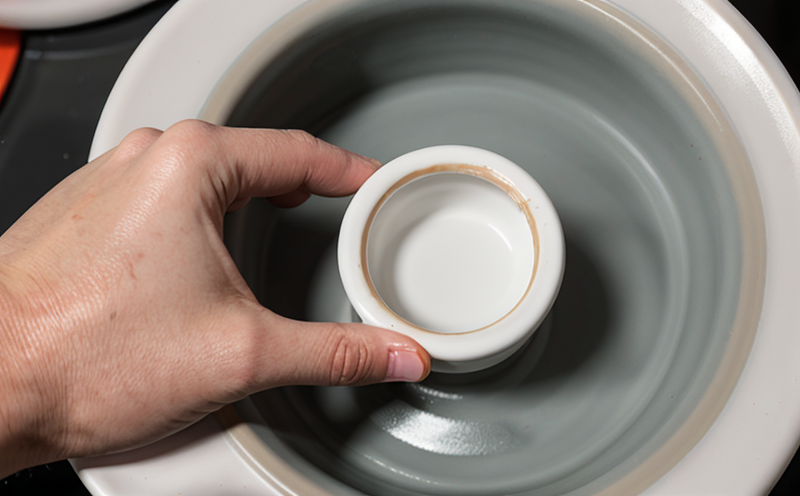Nanostructured Ceramics Testing
Understanding and characterizing nanostructured ceramics is critical in modern materials science. These materials find applications in a wide range of sectors including aerospace, electronics, automotive, and biotechnology due to their unique properties such as high strength-to-weight ratio, thermal stability, and chemical resistance. The testing of these nanostructured ceramics ensures that they meet the required performance standards before being incorporated into end products.
The first step in nanostructured ceramics testing involves thorough sample preparation which often includes grinding, sieving, and dispersing to achieve a uniform distribution of nanoparticles within the ceramic matrix. Once prepared, various characterization techniques come into play:
- Transmission Electron Microscopy (TEM) for direct visualization of particle morphology,
- Scanning Electron Microscopy (SEM) to observe surface features at higher magnifications,
- X-ray Diffraction (XRD) to determine crystalline structure and phase purity,
- Infrared Spectroscopy (IR) to identify functional groups present.
The testing process for nanostructured ceramics is not limited to just visual observation; mechanical properties must also be evaluated. This includes hardness, tensile strength, compressive strength, and modulus of elasticity which are crucial in determining the suitability of these materials for specific applications. For instance, aerospace components require high-strength while biomedical implants need biocompatibility.
Another key aspect is electrical conductivity testing since certain nanostructured ceramics possess unique electronic properties making them suitable for use in electronics. This involves measuring resistivity and dielectric constant under controlled conditions to ensure reliability.
Environmental stability tests are also essential as these materials may be exposed to harsh environments during their lifecycle. Durability against temperature changes, humidity levels, and chemical attacks is tested using accelerated aging methods following industry standards like ASTM F1980 for high-temperature testing or ISO 7541 for resistance to salt spray.
Finally, safety assessments are conducted ensuring compliance with relevant regulations such as REACH for potential health hazards. Compliance officers need reliable data from these tests to make informed decisions about material selection and process optimization.
| Applied Standards | Description |
|---|---|
| ISO 15666:2013 | Method for Determination of Particle Size Distribution in Nanomaterials by Laser Diffraction. |
| ASTM E1491-17 | Standard Practice for Characterizing Nanoparticles Using Transmission Electron Microscopy (TEM). |
Why It Matters
The importance of nanostructured ceramics testing cannot be overstated, especially in sectors where performance and reliability are paramount. By rigorously testing these materials, manufacturers can ensure that they meet not only internal quality standards but also external regulatory requirements.
For instance, aerospace manufacturers rely on nanostructured ceramics for engine components because of their ability to withstand extreme temperatures without degrading. Inaccurate or incomplete testing could lead to catastrophic failures in flight-critical systems, posing significant risks both to safety and reputation.
In the medical field, biocompatibility is crucial when using nanostructured ceramics in implants. Poorly tested materials can cause adverse reactions leading to patient harm. Thus, thorough testing ensures that these products are safe for use.
Moreover, efficient production processes demand precise material characterization. Any deviation from expected properties could result in wasted resources and time. Therefore, continuous monitoring through comprehensive testing protocols helps maintain optimal productivity levels.
The economic implications of reliable nanostructured ceramics testing extend beyond individual companies; they contribute positively towards global industrial growth by fostering innovation and competitiveness among nations.
Applied Standards
| Applied Standards | Description |
|---|---|
| EN 13857:2014 | Standard for the Determination of Porosity in Ceramics by Mercury Intrusion Pore Size Distribution. |
| IEC 60968-2-1:2015 | Specification for Nanomaterials – Particular Aspects Concerning Electrical Resistance and Conductivity Measurements. |
Industry Applications
- Aerospace: Use in engine components requiring high-temperature resistance.
- Electronics: Integration into circuit boards for enhanced performance.
- Automotive: Application as catalyst supports improving fuel efficiency.
- Biotechnology: Utilization in implantable devices ensuring biocompatibility.
Nanostructured ceramics find extensive use across various industries due to their versatile properties. Their ability to enhance product performance while maintaining cost-effectiveness makes them invaluable assets.
| Industry Applications | Description |
|---|---|
| Battery Technology | Incorporation into electrodes increasing energy density and lifespan. |
| Optoelectronics | Development of efficient light-emitting diodes (LEDs). |





